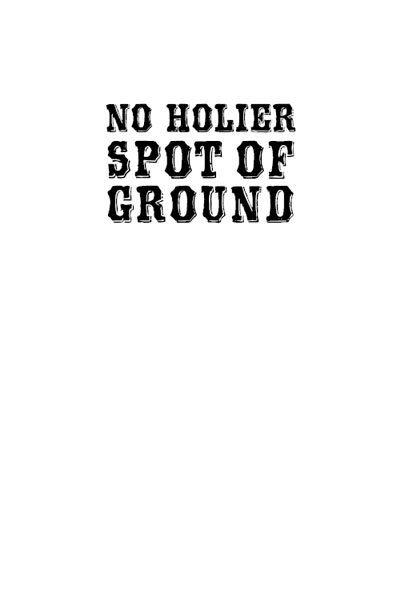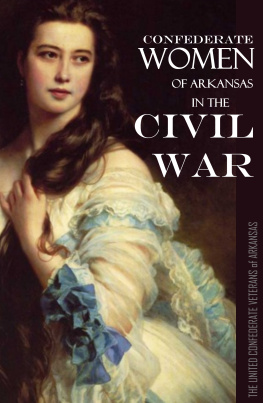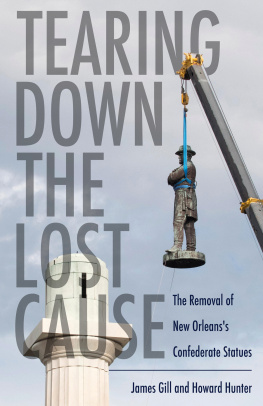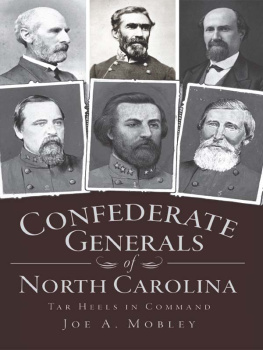

Published by The History Press
Charleston, SC 29403
www.historypress.net
Copyright 2009 by Kristina Dunn Johnson
All rights reserved
First published 2009
Second printing 2010
e-book edition 2012
ISBN 978.1.61423.282.7
Library of Congress Cataloging-in-Publication Data
Johnson, Kristina Dunn.
No holier spot of ground : Confederate monuments and cemeteries of South Carolina /
Kristina Dunn Johnson.
p. cm.
print edition ISBN 978-1-59629-397-7
1. South Carolina--History--Civil War, 1861-1865--Monuments. 2. United States
-History--Civil War, 1861-1865--Monuments. 3. Cemeteries--South Carolina. 4. Soldiers monuments--South Carolina. 5. War memorials--South Carolina. 6. Historical markers--South Carolina. 7. Soldiers monuments--Southern States. I. Title.
E645J645 2009
973.76--dc22
2009004389
Notice: The information in this book is true and complete to the best of our knowledge. It is offered without guarantee on the part of the author or The History Press. The author and The History Press disclaim all liability in connection with the use of this book.
All rights reserved. No part of this book may be reproduced or transmitted in any form whatsoever without prior written permission from the publisher except in the case of brief quotations embodied in critical articles and reviews.
Dedicated in memory of
Elizabeth Fox-Genovese
and
Rebecca A. Lyons
Thank you both for your loving encouragement.
Your mentorship has made me a better person and historian.
Ode to Magnolia Cemetery
Sleep gently in your humble graves,
Sleep martyrs of a fallen cause;
Though yet no marble column craves,
The pilgrim here to pause.
In the seeds of laurel in the earth
The blossom of your fame is blown,
And somewhere waiting for its birth,
The shaft is in the stone.
Meanwhile, behalf your tardy years
Which in trust keep your storied tombs,
Behold! your sisters bring their tears,
And these memorial blooms.
Small tributes! but your shades will smile
More proudly on these wreaths today,
Than when some cannon-moulded pile
Shall overlook this bay.
Stoop angels, hither from the skies!
There is no holier spot of ground
Than where defeated valor lies,
By mourning beauty crowned!
CONTENTS
ACKNOWLEDGEMENTS
The beginnings of this book started when I was in high school, when my parents agreed to take me to Civil War battlefields on spring break instead of the beach. Visiting Gettysburg, Appomattox, Manassas, Sharpsburg and other battlefields, I snapped pictures of all the Confederate monuments that I saw, not yet fully understanding their meaning. And, although my brother complained about how every battlefield looked the same, even he is now intrigued by the stories of the war and its legacy. Mom, Dad, PJI can never thank you enough for all of your support.
I could not have written this book without the loving support of my husband, Tommy. He stuck with me through all my episodes of writers block and kept pushing me toward this goal. He became an invaluable research assistant, helping with pictures and finding interesting stories. This book is greatly enhanced by having him in my life.
Additionally, Gordon Jones at the Atlanta History Center played a critical role in the development of this book by teaching me the importance of the myth and memory of the war. I hope that I do justice to the topic of monumentation in your home state! Thank you for teaching me about the importance of understanding the historiography of the wars legacies.
I would be remiss not to thank the supportive staff of the South Carolina Confederate Relic Room and Military Museum: Allen Roberson, Sarah W. Garrod, Joe Long, Jai Cassidy-Shaiman, Rachel Cockrell, John Bigham and Shirley Schoonover. I am proud to work alongside all of you. Thank you for your help with this project and letting me bounce ideas off of you. I also appreciate the support of the Gettysburg National Military Park during my time there, especially the friendship and research assistance of Terry Latschar, John Latschar, Troy Harman, Becky Lyons, Greg Coco, Winona Peterson, Kathy Georg Harrison, Linda Neylon, Janet Bucklew, Scott Hartwig and John Heiser. Gratitude is also due to John Sherrer, Kaela Harmon, Ann Posner, Jackie Rhodes and Robin Waites, who supported me during my work at Historic Columbia Foundation.
The efforts of the South Carolina Division of the Sons of Confederate Veterans and the United Daughters of the Confederacy have been invaluable. Thank you for patiently listening and providing insight to my talks on Confederate monuments and cemeteries. I tried to incorporate as many of your stories as I could, but I was unable to include everything. I would especially like to thank the members of SCV Palmetto Camp #22 in Columbia; SCV H.L. Hunley Camp #143 in Summerville; SCV Brigadier General Samuel McGowan Camp #40 in Laurens; UDC Mary Boykin Chesnut Chapter #2517 in Columbia; and UDC Ellison Capers Chapter #70 in Florence. Especially helpful were Frank Berry, Dean Stevens, Ashley Stevens, Tom Elmore, Krys Wood-Elmore, Robert Roper III, Gary Davis, Nita Keisler and Kevin Lassen. I am also indebted to the earlier work done by the UDC Wade Hampton Chapter #29 in Columbia while it oversaw the Confederate Relic Room collection. Please continue to preserve and protect your local monuments and cemeteries.
I appreciate the support of the Emory History Department and the University of South Carolina History Department while I researched topics surrounding the development of the memory and legacy of the Civil War, especially Elizabeth Fox-Genovese, Paige Putnam-Miller and Thomas Brown.
Thanks is also due to the research assistance and support given to me by Lindsay Pettus, Louise Pettus, James Clary, Dale Molina, Robert W. Foster, Garry Adelman, Neill Rose, Jennifer Scheetz of the Charleston Museum, Mike Coker at the South Carolina Historical Society, Robin Copp of the South Caroliniana Library, Donna Alley of the Beaufort Planning Department, Susie Baier at Elmwood Cemetery, Eric Emerson at the Charleston Library, Ann Evans of the Springs Close Family Archives (the White Homestead) and Wade Dorsey and Patrick McCauley at the South Carolina Department of Archives and History. The staff of Beaufort National Cemetery was also very helpful. I appreciate all of the work done by Robert Seigler in his earlier book to catalogue all of the Confederate monuments in the state. I would also like to thank Dan Gidick for connecting me with The History Press. I appreciate the assistance of my editor, Laura All, and the staff of The History Press for getting this book to the public.
INTRODUCTION
NO HOLIER SPOT OF GROUND
As Henry Timrod, the Poet Laureate of the Confederacy, read his Ode to Magnolia Cemetery during the 1867 Memorial Day services at Charlestons Magnolia Cemetery, he could not have foretold just how many marble columns would someday grace the Southern landscape. During a time when many Southerners were attempting to cope with defeat and gather their dead, Timrod recognized an underlying desire to create permanent memorials to the tragedy. His words inspired the gathered crowd and reminded them that after the immediacy of mourning, memorialization would help future generations remember the Souths pain and sacrifice.
Next page







